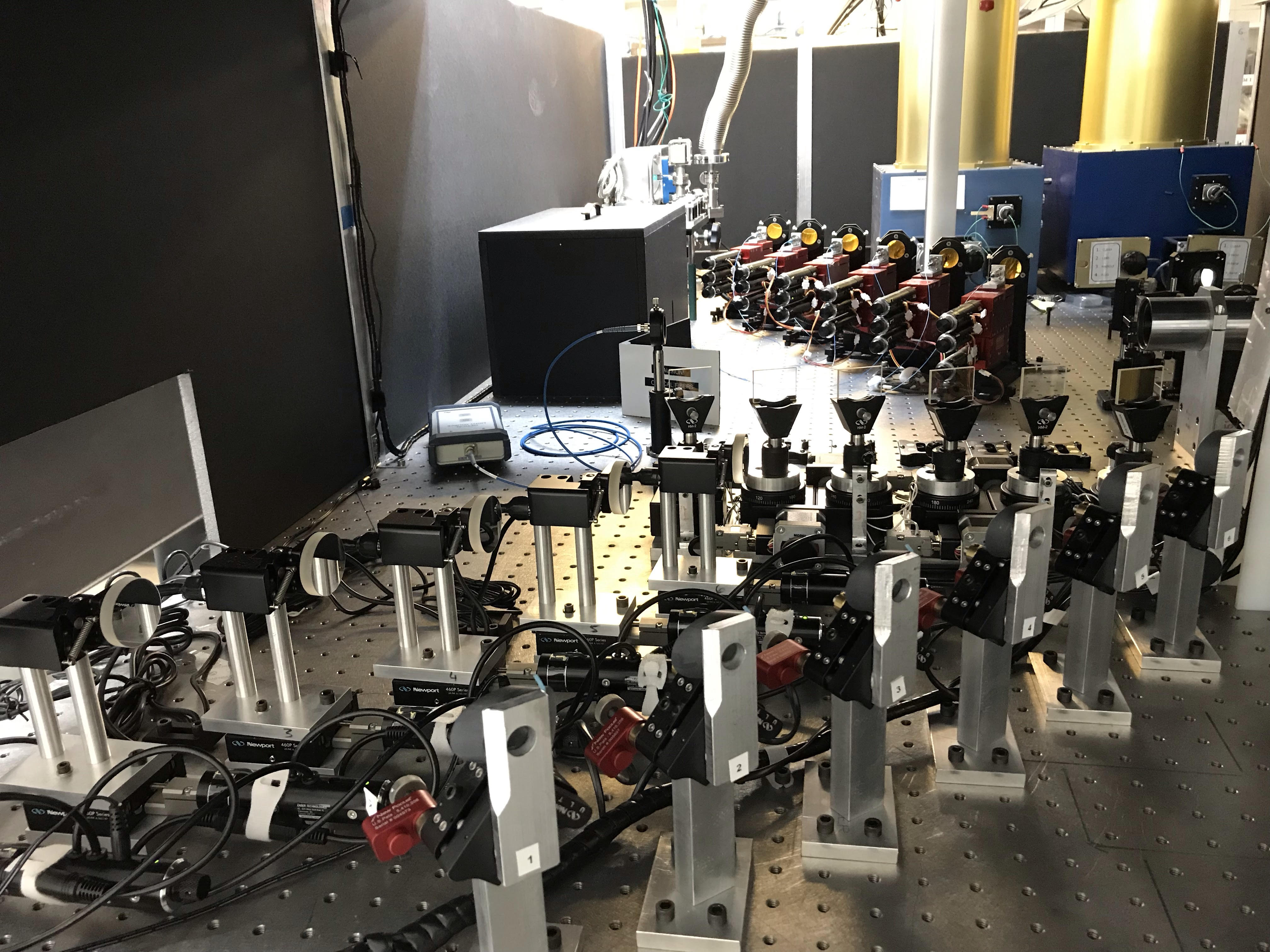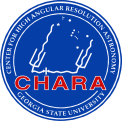The upgraded MIRC-X and recently commissioned MYSTIC beam combiners at the CHARA array combine the light from all six telescopes simultaneously. MIRC-X disperses light across several spectral channels and operates in the near infrared J and H-bands. MYSTIC operates at longer wavelengths in the near infrared K-band. MIRC-X/MYSTIC can be used simultaneously to create images of stellar surfaces and circumstellar disks. The precision closure phases are well suited to detecting faint binary companions.

MIRC-X injects the light from each telescope into optical fibers for spatial filtering.The fiber outputs from the six beams are arranged in a linear non-redundant pattern to spatially encode the fringes from each pair of telescopes. The combined light passes through a spectrograph and is imaged on the detector.
Three spectral modes are currently available in the H-band: prism R=50 (8 spectral channels), prism R=102, and grism R=190. A higher resolution grism with R=1170 is available with approval from the instrument team.
The simultaneous J+H mode using 4 telescopes is under development for MIRC-X. Contact the instrument team if you are interested in using the J+H mode.
MYSTIC, the Michigan Young STar Imager at CHARA is a K-band, cryogenic, 6-beam combiner. The design follows the image-plane combination scheme of the MIRC instrument where single-mode fibers bring starlight into a nonredundant fringe pattern to feed a spectrograph. Beams are injected in polarization-maintaining fibers outside the cryogenic dewar and transported through a vacuum feedthrough into the 220K cold volume where combination is achieved and the light is dispersed.
MYSTIC is available in the K-band using a low-resolution R=49 prism. Additional spectra modes (prism R=22, prism R=49, grism R=278, grism R=981, grism R=1724) were installed in February 2022. Contact the instrument team if you are interested in using one of the newly installed modes. A 4-telescope mode for MYSTIC using an integrated optics component designed for the VLTI-GRAVITY experiment is under development and will provide better sensitivity for the faintest targets.
Both MIRC-X and MYSTIC use low read-noise C-RED ONE cameras developed by First Light Imaging based on the eAPD SAPHIRA detector that provide near-photon-counting performance. The instrumentation development of the upgraded MIRC-X combiner was led by Stefan Kraus at University of Exeter and John Monnier at the University of Michigan. The first phase of the MIRC-X commissioning was successfully completed in June 2017 after the installation of the C-RED ONE camera. The second phase was completed in September 2018 after a new-generation beam combiner was installed to maximize sensitivity, extend the wavelength coverage into the J-band, and enable polarization observations. MYSTIC was developed by John Monnier and installed and commissioned at the CHARA Array in August 2021.
The original Michigan Infrared Beam Combiner (MIRC) was developed by John Monnier and his optical interferometry group in the Astronomy Department at the University of Michigan. MIRC dispersed light across 8 spectral channels in the near infrared H-band (1.6 microns). It was commissioned on sky in 2005. MIRC produced the first images of a main sequence star other than the sun, measured the oblateness and gravity darkening of rapid rotators, imaged starspots on the surface of magnetically active stars, and detected faint binary companions at small separations.
Observing and Data Reduction
Data Reduction Manual for MIRC-X and MYSTIC
Guide for reducing older MIRC-4T and MIRC-6T data
Observing Logs
MIRC-X 6T Observing Log: standard beam order [Letter size pdf] [A4 size pdf]
MIRC-X 6T Observing Log: free beam order [Letter size pdf] [A4 size pdf]
Instrument Papers for MIRC-X (Commissioned in June 2017):
MIRC-X: a highly-sensitive six telescope interferometric imager at the CHARA Array - Anugu et al. 2020, AJ, 160, 158
The MIRC-X 6-telescope imager: Key science drivers, instrument design and operation - Kraus et al. 2018, SPIE, 10701, 23
MIRC-X/CHARA: sensitivity improvements with an ultra-low noise SAPHIRA detector - Anugu et al. 2018, SPIE, 10701, 24
Instrument Papers for MYSTIC (Commissioned in August 2021):
MYSTIC: Michigan Young STar Imager at CHARA - Monnier et al. 2018, SPIE, 10701, 22
Instrument Papers for MIRC (Operational from 2006 to April 2017):
The Michigan Infrared Combiner (MIRC): Infrared imaging with the CHARA Array - Monnier et al. 2004, SPIE, 5491, 1370 (pdf)
Michigan Infrared Combiner (MIRC): Commissioning Results at the CHARA Array - Monnier et al. 2006, SPIE, 6268, 1 (pdf)
High precision interferometer: MIRC with photometric channels - Che et al. 2010, SPIE, 7734, 2
Imaging from the first 6-beam infrared combiner - Che et al. 2012, SPIE, 8445, 0



